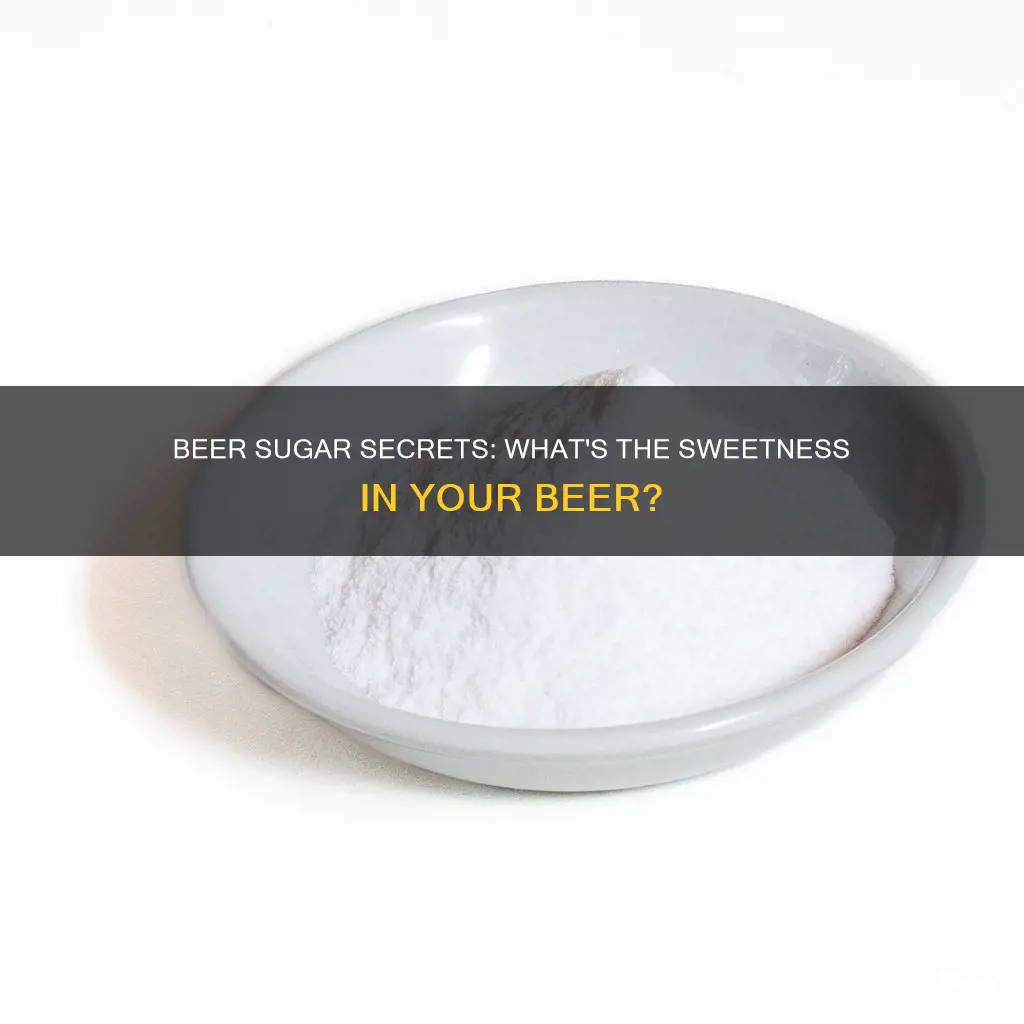
Beer is made from grains, spices, yeast, and water. While sugar is not added to the list, it is created naturally when the grains are processed and fermented by yeast. The most common sugar in beer is maltose, which is made from two glucose molecules. The sugar content of beer depends on several factors, including its gravity, type of yeast, and any additional flavours. Beer typically has a low sugar content, but non-alcoholic beer has a higher sugar content than alcoholic beer.
What You'll Learn
- Beer's sugar content is created by the density of the liquid extracted during brewing
- Beer is made up of yeast, grains, spices, and water
- Beer gravity influences both the sweetness and alcohol content of beer
- Beer contains fermentable and non-fermentable sugars
- The amount of sugar in beer depends on the type of beer

Beer's sugar content is created by the density of the liquid extracted during brewing
Beer is generally made from yeast, grains, spices, and water. Sugar is not usually listed as an ingredient, but it is created naturally when the grains are processed and fermented by yeast. This process is called mashing, and the sugar-containing liquid it produces is called wort. The density of the wort is referred to as beer gravity, and it is mostly determined by sugar content. A wort with a high sugar concentration is called a high gravity wort.
Once yeast is introduced to the wort, it ferments the sugars into alcohol and carbon dioxide, creating beer. As the yeast ferments the wort, its sugar content decreases while its alcohol content increases. This process, called fermentation, results in a beer with a lower gravity and a higher alcohol content.
After the fermentation process is complete, beer is typically comprised of 80% fermentable sugars and 20% oligosaccharides, a type of carbohydrate that is not fermented by yeast or digested by the human body. Thus, the final sugar content of a beer depends on several factors, including its gravity, the type of yeast used, and any additional flavourings such as honey or corn syrup.
The sugar content of beer is generally very low, but it is worth noting that non-alcoholic beers tend to have a higher sugar content than light or regular beers. This is because none of the sugar in non-alcoholic beers is converted into alcohol.
Best Low-Sugar Beers: Enjoy Guilt-Free Sipping
You may want to see also

Beer is made up of yeast, grains, spices, and water
Beer is made up of four primary ingredients: yeast, grains, hops (a type of spice), and water. The grains used are typically barley, wheat, rice, corn, oats, or rye. The barley and wheat must undergo a malting process before they can be used to make beer, which involves soaking the grains in water to germinate them and then drying them to halt further growth. This process converts the starches in the grains into simple, fermentable sugars, the most common of which is maltose. The malted grains add flavour, body, and colour to the beer.
The hops, which are the flowers of a perennial vine, provide a piquant aroma, a variety of flavours, and a delicate-to-intense bitterness that balances the sweetness of the malt. The yeast consumes the sugars derived from the malted grains and excretes alcohol and carbon dioxide in return.
While not considered a primary ingredient, sugar is essential to the beer-making process. It is created naturally when the grains are processed and fermented by yeast. The density of the liquid extracted from the mashing process, known as the wort, determines the beer's gravity, which refers to the relative density of the wort to water during the different stages of fermentation. When the wort has a lot of sugar, it is known as a high-gravity wort. Once yeast is introduced, the sugar content generally decreases while the alcohol content goes up.
Australian Beer: Low-Sugar Options for the Health-Conscious
You may want to see also

Beer gravity influences both the sweetness and alcohol content of beer
Beer gravity, or specific gravity, is a key concept in brewing that refers to the density of the wort—the liquid extracted from the mashing process—compared to the density of water. This density is influenced by the amount of sugar in the wort, which is derived from the grains used in the brewing process.
During fermentation, yeast consumes the sugars in the wort, converting them into alcohol and carbon dioxide. This process decreases the sugar content of the wort while increasing its alcohol content, thereby reducing its density or gravity. Thus, beer gravity is a reflection of the amount of sugar in the beer, which, in turn, influences its alcohol content.
The original gravity (OG) of a beer indicates the number of dissolved sugars present that can be converted into alcohol. Beers with a higher original gravity will typically result in a higher-alcohol beverage. Conversely, session beers and dry, less sweet beers have lower original gravities, resulting in lower-alcohol content.
The final gravity (FG) of a beer is measured after fermentation and indicates the remaining sugar content. While a higher FG often correlates with a sweeter taste, this is not always the case. The presence of complex, unfermentable dextrins can result in a high FG without a corresponding increase in sweetness. Additionally, factors such as hop bitterness, alcohol content, and mash temperatures can influence the perceived sweetness of a beer.
In summary, beer gravity is a critical factor in brewing that influences both the sweetness and alcohol content of the final product. Brewers carefully control the gravity during the various stages of the brewing process to achieve the desired balance of sweetness and alcohol in their beers.
Sugar in Budweiser Beer: How Many Grams?
You may want to see also

Beer contains fermentable and non-fermentable sugars
Beer contains both fermentable and non-fermentable sugars. The fermentable sugars are derived from the fermentation process, where yeast converts sugars into alcohol and carbon dioxide. The non-fermentable sugars, such as oligosaccharides, are not digested by the yeast and remain in the beer, adding sweetness and body.
The amount of sugar in beer depends on various factors, including the type of beer, the ingredients used, and the brewing process. Regular beers typically contain moderate amounts of fermentable sugars, which are converted into alcohol. Light beers are crafted to be lower in calories and carbs, with less sugar and alcohol content. Non-alcoholic beers, on the other hand, can sometimes have higher sugar levels than alcoholic versions since the sugars are not converted into alcohol.
The two primary families of beer are ales and lagers, which differ in the type of yeast used and their fermentation processes. Ales are fermented with Saccharomyces cerevisiae, a top-fermenting yeast that works best at warmer temperatures. This yeast tends to ferment quickly and can result in a higher alcohol content, but it may leave behind less sugar. Lagers, on the other hand, use Saccharomyces pastorianus, a bottom-fermenting yeast that prefers cooler temperatures and ferments more slowly, resulting in a crisper and slightly sweeter beer.
The sugar content in beer also varies depending on the specific style. India Pale Ales (IPAs) tend to have a higher level of residual sugars, contributing to a fuller body. Stouts can range widely in sugar content, with dry stouts having lower sugar levels and milk stouts or imperial stouts being on the sweeter side. Traditional lagers are crafted to be crisp with a subtle sweetness, while wheat beers are generally on the sweeter side.
The role of sugar in brewing is crucial, as it influences both the sweetness and alcohol content of the beer. Beer gravity, which measures the density of the wort before and after fermentation, is a crucial concept in understanding the sugar content of beer. High gravity beers have more residual sugars and stronger flavours, while low gravity beers are lower in alcohol content and residual sweetness.
In summary, beer contains both fermentable and non-fermentable sugars. The amount and type of sugar in beer depend on various factors, including the ingredients, brewing process, and specific style. The fermentation process plays a key role in determining the final sugar and alcohol content of the beer.
Budweiser Beer: Sugar Content and Nutritional Facts
You may want to see also

The amount of sugar in beer depends on the type of beer
The Beer-Making Process
The amount of sugar in beer depends on how it is made. Beer is made from four basic ingredients: water, grains (often barley or wheat), hops, and yeast. The first step is malting, where grains are soaked, germinated, and dried to convert starches into fermentable sugars. The malted grains are then soaked in hot water to create a sweet liquid called wort. During boiling, hops are added for flavour and bitterness, and the wort is sterilised. Once the wort is cooled, yeast is introduced and ferments the sugars, producing alcohol and carbon dioxide. The final step is maturation, where the beer develops flavours and carbonation.
Fermentation and Residual Sugars
The amount of sugar in beer depends on the fermentation process, where yeast converts fermentable sugars into alcohol and carbon dioxide. While most sugars are converted, some residual sugars remain, contributing to the beer's taste and body. The type of yeast and the fermentation process influence the final sugar content. For example, ales are fermented with Saccharomyces cerevisiae, a top-fermenting yeast that works at warmer temperatures and can digest a variety of sugars, resulting in a higher alcohol content. In contrast, lagers use Saccharomyces pastorianus, a bottom-fermenting yeast that prefers cooler temperatures and ferments more slowly, resulting in a crisper and slightly sweeter beer.
Beer Styles and Sugar Content
Different beer styles, such as ales, lagers, and stouts, have distinct sugar profiles due to variations in yeast activity, brewing temperatures, and ingredients used. Regular beers typically contain moderate amounts of fermentable sugars, which are converted into alcohol. Light beers are crafted to be lower in calories and carbs, with less sugar and alcohol content. Non-alcoholic beers can have higher sugar levels than alcoholic versions since the sugars are not converted into alcohol.
Beer Gravity and Sugar Content
Beer gravity refers to the density of the wort and influences both the sweetness and alcohol content of the beer. High gravity beers have more residual sugars and stronger flavours, while low gravity beers are lighter in alcohol content and residual sweetness. The type of malt and the extent of its roast also impact the final sugar content. Darker malts used in stouts and porters contribute non-fermentable sugars, adding sweetness and body to the beer.
Specific Beer Types and Sugar Content
The sugar content varies across different beer types. Pilsners are usually light and crisp with less than 2 grams of sugar. India Pale Ales (IPAs) are hoppier and range from 3 to 4 grams of sugar. Stouts can have up to 6 grams of sugar, especially those with chocolate or coffee flavours. Porters are similar but lighter, with 3 to 5 grams of sugar. Wheat beers are generally sweeter, with around 4 to 5 grams of sugar. Sour beers can vary widely, with 2 to 8 grams of sugar depending on fruit content. Lagers are crisp and golden, typically containing about 2 grams of sugar. Amber ales fall in the middle, with around 3 grams of sugar.
The Sweet Secret: Residual Sugar in Beer
You may want to see also
Frequently asked questions
The main type of sugar found in beer is maltose, which is made from two glucose molecules.
The sugar in beer comes from the grains used in the brewing process. During the malting step, grains are soaked in hot water to germinate, which converts starches into fermentable sugars.
The amount of sugar in beer varies depending on the type and brand. Regular beers typically have minimal sugar, with most being fermented during the brewing process. Light beers tend to have slightly more sugar, while non-alcoholic beers have the highest sugar content.
Beer can affect blood sugar levels by interfering with the liver's ability to produce glucose. This can lead to hypoglycemia, or low blood sugar levels. Therefore, it is generally recommended to consume beer with a carb-containing meal to compensate for the expected drop in blood sugar.







